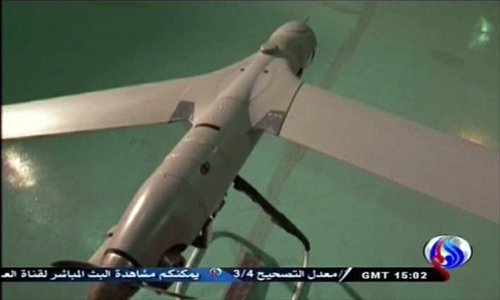Doubt cast on drone claims
With at least four US-made drones supposedly in hand, Iran trumpeted its latest progress in electronic warfare amid a growing showdown in the covert intelligence war with the US and its ally Israel. But analysts cautioned that reality might not resemble Iran's claims.
"I don't believe Iran has acquired the ability to hunt down US stealth drones that are sent to fly over Iranian territory and collect intelligence on Iran's nuclear program and military sites," a Chinese military who spoke on condition of anonymity and has close ties with the unmanned aerial vehicles(UAV) designing and manufacturing industry told the Global Times.
Early this month, Iran's Islamic Revolutionary Guard Corps (IRGC) exhibited on state TV a captured ScanEagle, a less sophisticated surveillance unmanned drone designed by Boeing. The IRGC said the drone had been flying over the Persian Gulf and was landed down when it strayed into Iranian airspace. But it didn't give the exact date of the seizure.
Mysterious capture
An Iranian official, who declined to be named because of the sensitivity of this issue, told the Global Times that Iran was "awaiting the US response" between the capture and announcement of the capture. "Unfortunately, we didn't receive any signal from our US friends showing their willingness to discuss this issue that may embarrass them. So we decided to make it public," the official said.
About a week later, the naval chief of IRGC Iranian forces had shot down at least two spy drones of the same model as displayed on TV. Although Iran asserted that it had "material evidence to prove that the drone we captured belongs to the US," it has not shown any evidence, such as US military markings, to the media.
The US Fifth Fleet, which is responsible for naval forces in the Persian Gulf, Red Sea, Arabian Sea, and coast off East Africa, denied any of its drones went missing recently.
"The message that we want to deliver to our US friends by announcing the capture is as simple as that Iran has gained the capability to hunt down the US drones," the Iranian official said. "Of course, the Americans were reluctant to accept the fact, so they denied it."
In terms of electronic and cyber war, Iran is in a position to take control of the navigation system of drones, cut their connection with the satellites guiding them or the control center stationed on the warships and bring them down intact, said an conservative Iranian news website, rajanews.com.
Failed attempt
But the Chinese military analyst cast doubts on Iran's depiction of events. If Iran had really mastered the skills needed to hunt down US drones via electronic warfare, the Iranian forces should have brought down a much larger number of US drones and more sophisticated models, the analyst said.
"A recently failed Iranian attempt to obtain Israeli-made drone in Azerbaijan could probably help us establish a clue to the mysterious capture of ScanEagle," the analyst indicated.
About two weeks ago, the Azerbaijani police reportedly rounded up six Iranian agents who had infiltrated the country and were found "in possession of cash, fake passports, automatic pistols, advanced electronic equipment for tracking aircraft and electronic warfare devices for jamming flying vehicles and down them."
Through questioning the Iranian detainees, the Azerbaijani police found they were looking for the air bases where Azerbaijan houses the Hermes-450 drones it purchased from Israel. The Iranian spy ring was trying to net a Hermes-450 as it flew over the Caspian Sea, it said, adding that Tehran was suspected of planning to present it as the capture of an Israeli spy drone controlled by the Israeli Air Force and military intelligence, although without Israeli military markings.
Cheap copy
In late 2011, Iran captured a much bigger and more sophisticated US stealth drone, a bat-winged RQ-170 Sentinel, which was reported lost by US forces in neighboring Afghanistan. Tehran said at that time that it would reverse-engineer that drone to make its own and now claimed having "fully deciphered" all data saved on the RQ-170.
After the seizure of the ScanEagle, the IRGC said data had been extracted from the drone, from which Iran found the US was "gathering intelligence on military objectives as well as the energy sector, particularly oil transitions at terminals."
Iranian Defense Minister Ahmad Vahidi said last week that Iran has established an unmanned drone manufacturing line, copying both the RQ-170 and ScanEagle drones.
An official from the Iranian embassy in Beijing also confirmed with the Global Times that Iran has shared part of its findings on the captured US drones with some other countries. Asked whether Iran is willing to share the knowhow on hunting the US drones, the official responded, "Of course, why not?"
But the Chinese military analyst believed it would be hard for Iran to retrieve the data, at least not all of it, from the US drones.
"All the intelligence data on the US-made drones will be automatically wiped if the drone loses contact with its command base," the analyst said. "At the same time, the US military electronic system codes are extremely complicated so that we even can't exclude the possibility that the drones might be a Trojan horse sent by the US to test Iran's electronic warfare capability."
As for the Iranian-made drones, the analyst said the one shot down by Israel suggested it is only at the starting stage.
In October, the Israeli air force spotted an unmanned aerial vehicle and shot down after it travelled east some 55 kilometers across Israel's southern Negev desert. Israeli military spokeswoman Avital Leibovich said that"We are witnessing lately in the region a very big and thriving industry for UAVs and of course we are following those attempts closely."
Agencies contributed to this story
